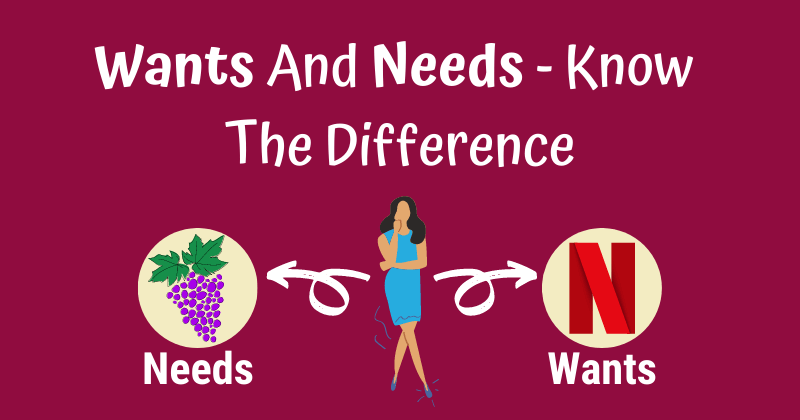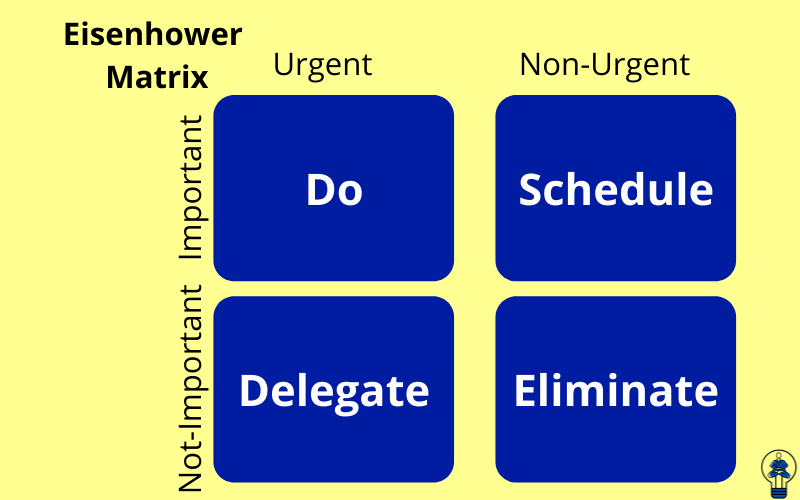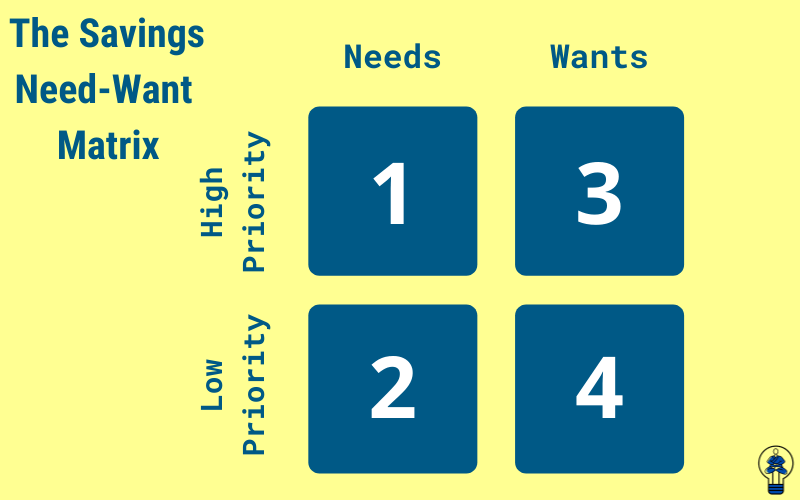Needs VS Wants: How To Tell The Difference?

This article may contain affiliate links. If you make a purchase using my links, I’ll earn a small commission at no extra cost to you. I appreciate your support!
Needs Vs Wants? Do you know how to separate the two easily? Can you identify if an iPhone 13 Pro is a Need or a Want?
Needs and Wants are two completely different words often interchanged depending on our desires and emotional state.
Understanding the difference between a Need and a Want plays a big role in your financial journey.
It even applies to real-life situations.
Although the meaning and definition of both these words are easy to comprehend and self-explanatory, we humans mess up the meaning between Needs and Want leading to heavy financial expenditures and debt which we can’t afford to repay.
To not fall into this trap, let’s discuss in simple yet understandable words, the difference between Wants and Needs to ensure you can tell the difference and not fall into the Wants trap!
Definition of Need and Want
A quick Google search shows the following:
Needs: Require (something) because it is essential or very important rather than just desirable.
Wants: have a desire to possess or do (something); wish for.
Needs definition clearly states that only an “essential” item can be considered as a need.
While wants definition says that having a desire is equivalent to wants. Desire isn’t Essential. That’s why wants should be at a minimum.
What are Needs and What are Wants?
I Need a place to live, I Need food to eat every single day, I need to have clothes to wear without which I can’t work.
A Need is something you have to have without which there can be serious problems or without which you cannot live.
It’s like a compulsion, you cannot stay without a house nor can you without clothes or live without food to eat.
But do you need a lavish two-bedroom-hall-kitchen or supreme high-quality goods or branded clothes? No! That’s Not necessary.
These are your Wants. We all have needs and wants and quite often can’t distinguish between the two.
So the question remains: How do I figure out what’s necessary and what’s not?
In normal words, what is my Need and what is my Want?
Well, the answer lies in the year 1954 when Eisenhower created the Urgent important matrix to help us be more productive and assign our tasks well by simply prioritizing our tasks based on the level of urgency and importance of each task.
Eisenhower Urgent-Important Principle
Dwight D. Eisenhower was the 34th President of the United States right from 1953 until 1961. He developed a practical and logical approach to determining whether a situation is urgent, important, not important, and not urgent.

This matrix is a useful tool for time management, getting things done, and setting priorities. If you’re a person who struggles with this(I can’t think of anyone who doesn’t struggle with this), you can use the Eisenhower matrix.
Okay, but how does this principle help us to understand the difference between Wants and Needs?
We use the same principle used in the Eisenhower principle and create a 2×2 table to help us make a smart decision.
The Eisenhower Decision Matrix is the easiest time management strategy for your productivity.
If we tweak this matrix for our specific requirements, we get the following table.
The table below shows that our priorities should go on like this:
1. Needs and High Priority
2. Needs and Low Priority
3. Wants and High Priority
4. Wants and Low Priority
Let’s understand each of these properly using my Savings Need-Want Matrix
The Savings Need-Want Matrix

4. Want and Low priority
This is the last option in the table but the most important so let’s tackle it first. Things included in this table can be easily ignored.
The wants included here will refer to those wants without which we won’t have a boring life nor will our life suffer.
These generally include things that provide us instant gratification for some time and then it completely fades away.
Like a branded sports car, you might get so tempted to buy that car for a day, now if you fall so deep into this trap, you’ll end up buying the branded sports car, and then the next day you may think “I could’ve easily avoided this expense” but alas, it’s too late now.
You’ve ended up with a huge debt on your expense sheet. While buying things from the “Wants and Low priority” category might seem foolish, we are often trapped in an aimless pursuit of unnecessary things.
It’s a natural tendency. The only way to control is to realize that anything which belongs in this category isn’t want and is not a need.
If you come across these expenses, your immediate action must be to ignore them, avoid them. Full stop. That’s it!
3. Want and High priority
This is probably the trickiest part of all four. I believe you should spend on wants because they bring some fun in your life. But hold on, note that you shouldn’t spend more than 10% of your net income on wants.
Net income means income after the government deducts taxes. But how do we decide whether a want is a high priority or a low priority? For this, you need to self-analyze.
Is the want an urgent one? Will it affect your mental stability if you don’t spend on it or will you be at greater peace if you spend on the want?
What is that want that satisfies you for a long time, means if want can satisfy you for a very long time and the price of the want isn’t that much, you can consider it as a Want and High priority category.
And once you’ve completed spending on 1 and 2, you can consider this. No need to ignore these wants, just know how to prioritize and indulge in a few and avoid the rest.
2. Need and Low priority
Most of your needs will be high-priority needs. Here things like gym expenses come into play, which is a need but low priority because you may not be interested in workouts. But that doesn’t mean you ignore it.
You have to make sure that if it improves your lifestyle if it makes you productive, it’s a need and a high priority need. Such needs must be pushed up the ladder and shifted to Need and High Priority quadrant.
Needs and Low Priority quadrant is essential for living but not as essential and thus shouldn’t be your immediate expenses.
These expenses can wait for some time and are next in line after Need and High Priority.
1. Need and High priority
This quadrant is the ideal quadrant you should focus on. Everything that comes here should be completed.
This includes essential needs like basic groceries, clothes for the office, rent, minimum transportation expenses, and so on.
Yea sure this list can get long as we need a lot of things. The key here is to try eliminating needs that can be eliminated like if your office allows you to work from home, you can save money on transportation.
This way we eliminated a need. Similarly strategically thinking of ways to eliminate needs is the easiest way to save.
Sage Tip: Use Needs to satisfy your wants; learn to cook delicious meals at low cost, this satisfies a need as well as a want (eating delicious food).
Let’s take an example for a better understanding of how to apply the quadrants in a given situation.
Peter, your best friend bought an iPhone and now you want one too. Your current phone isn’t working properly and a new phone will be perfect to solve your problem.
You will consider it as a need but in practicality, it’s a want.
That’s because your phone is still functioning (even though it’s not how it used to work). It’s no harm having a want cause as humans, we can and we should satisfy our wants, right!
Let’s assess if we should choose the iPhone and how to go about in deciding whether the purchase is relevant or not.
Here the iPhone comes under the Want and High priority category. Why? Because you need a phone and your phone has a few glitches.
So now if and only if the first two priorities are completed and there isn’t a financial problem to complete the third priority, you can purchase the iPhone.
But if after completing priority 1 and 2, if your budget exhausts meaning if you’re low on money, you should not, I repeat, you SHOULD NOT complete priority 3 or 4, i.e don’t buy the iPhone.
Thus we can establish our wants and needs easily. Just because want is a high priority doesn’t mean it’s a high priority. I’m trying to say that don’t spend on a want just because it’s somewhat important.
Note: Ask someone else before making an impulsive decision. That way they can give you clarity on whether you should make the purchase or not. This helps you stay on track and not overspend.
Needs vs Wants – How To Effectively Budget Your Expenses?
Practically you should cut off 95% of your wants and only spend on needs. Spending 5-10% on wants is reasonable and is a must as you should enjoy your life and avoid being a miser.
This will also teach you how to properly utilize the 5% to maximize your wants. That works great because now you learn one of life’s biggest lessons – Creating happiness with less money.
It will not only help you to save money but also give you a good boost in your financial freedom journey.
Remember this is a strict principle but it doesn’t have to make your life miserable. We all deserve to be happy and enjoy our life, that’s exactly why you should spend at most 10% on your wants.
Do you have any doubts regarding the difference between Wants and Needs? Or do you have a few questions regarding The Matrix explained above? I’ll answer your questions in the comments below.
Have you enjoyed this post? If so, you might want to subscribe to my newsletter. It usually contains life lessons and money-related topics, some interesting observations, links to articles or books I’ve read, and tips to be a better person. If you’re interested in these things then subscribing will be simply wonderful 🙂 PS: Subscribe and Get your Freebie below!
Also, I’m a YouTuber now! If you’re interested in Pinterest Marketing, Blogging, or business-related things, Subscribe to my Channel and I’ll see you in the comments!